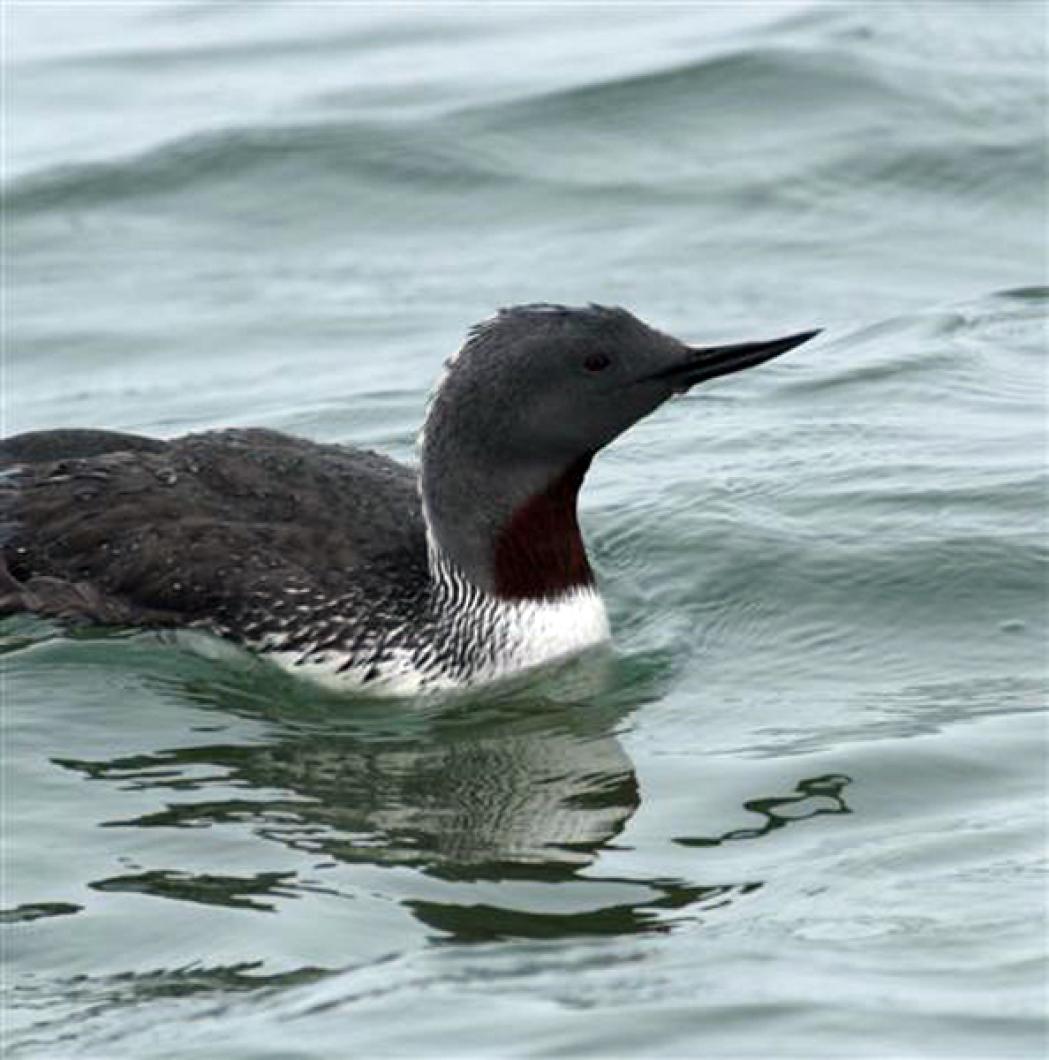I suppose that I should be writing about turkeys, but you have had your holiday meal, so I will just remind all of you that the turkeys on Martha’s Vineyard are not wild. They are a cross of domestic turkeys. One flock started at Elisha Smith’s farm in Edgartown and the other at Craig Kingsbury’s farm in Vineyard Haven. No doubt individuals from each have interbred. A true wild turkey is very wily and wouldn’t be caught on someone’s back porch.
Lanny McDowell and I ventured onto South Beach off the Pricilla Hancock Preserve in Chilmark on Nov. 19. There was a stiff breeze from the west and quite a surf. We scanned the waves with binoculars and a scope and were stunned by the incredible show of red-throated loons moving from east to west. There was a steady stream of loons, and they were still coming when we left. What drove numbers of these loons to fly into the teeth of a gale?
Red-throated loons appear on the waters surrounding the Vineyard in the winter months. The numbers vary from year to year, with close to 600 birds seen on one day (the Christmas Bird Count) in 2003. They are the smallest of the loons we see off the Vineyard. Others included common and the very rare Pacific loon. The red-throated loons breed in the high latitudes in ponds in the tundra. Unlike their cousins, they can take off from the surface of the water with less “runway” necessary.
The red-throated loons lose their red throats after breeding season, so when they reach the Island they are a study in gray and white. I have always called them the stuck-up loons, as they hold their bills upwards, while other loons carry them parallel to the water surface.
Loons feed on fish and it appears that when it is windy and the seas are turbulent, they come inshore to feed. Diving down, the loons capture fish in their bills, and then maneuver them so the head is facing them and proceed to swallow it under water. They leave the higher latitudes when the weather becomes harsh and the fish they feed on have migrated south.
The parade of red-throated loons we observed were probably seeking food close to shore, which enabled Lanny and me to see them and for Lanny to photograph them.
Bird Sightings
I could say it was a test to see if you birders were on your toes — a red-bellied merganser? There is no such bird. It was a mistake made by my fingers in last week’s column. Nice that so many of you noticed it. It lets me know I still have a reading public!
Bert Fischer counted 28 eastern bluebirds around his Aquinnah home on Nov. 16. He also spotted an American kestrel the same day.
Rob Culbert informed me that the roost of turkey vultures is back by the Tisbury School as of Nov. 16.
Allan Keith found it curious that so many blue-winged teal are still on the Island. They usually have moved south by October. On Nov. 5 he spotted a female blue-winged teal at Turtle Brook Farm in Chilmark. On Nov. 9 he and David Donsker birded Squibnocket and found two blue-winged teal, a white-crowned sparrow and two juncos. Then on Nov. 17 Allan spotted a single female blue-winged teal in the small pond by Gaymark in Chilmark. On. Nov. 15 Allan went to Aquinnah and spotted a snow bunting in the Circle and two peregrine falcons chasing an American kestrel. The kestrel probably went to Squibnocket when Bert saw it. Then I saw one at Quenames on Nov. 19. Allan also reported that there are still Forster’s terns on the rafts at Squibnocket and also a merlin. Allan counted 34 brant at Ocean Park on Nov. 16.
Peter Huntington called to say he counted four wood ducks in Upper Combs, off Tisbury Great Pond, on Nov. 13.
Bob and Phyllis Conway saw a lone Swainson’s thrush in their yard between 7 and 8 a.m. from Nov. 14 through Nov. 19. On Nov. 20 a small flock of 12 juncos was on their lawn pecking away. Sailing aloft over the Chilmark post office and nearby little woods are turkey vultures, as many as six daily. Must either be dead stuff or more likely a roost in the woods behind the school.
Jeff Bernier took his camera and binoculars to Squibnocket and spotted two northern gannets, one mature and one juvenile. Jeff counted five great cormorants, 10 black and eight surf, two horned grebes, a common loon, and four harlequin ducks. In Squibnocket Pond Jeff saw eight coots, five American widgeons, a pied-billed grebe, and some green-winged teals.
On Nov. 20, nine women from the Chilmark Ladies Movie Group joined me on a walk from Quenames to Black Point and back. Our best bird was a tree swallow. We also saw a small flock of eastern bluebirds, yellow-rumped warblers, green-winged teal, pied-billed grebe, black ducks and mallards and buffleheads to name a few.
Please report your bird sightings to the Martha’s Vineyard bird hotline at 508-645-2913 or e-mail birds@mvgazette.com. Susan B. Whiting is coauthor of Vineyard Birds and Vineyard Birds II. Her Web site is vineyardbirds2.com.





Comments
Comment policy »